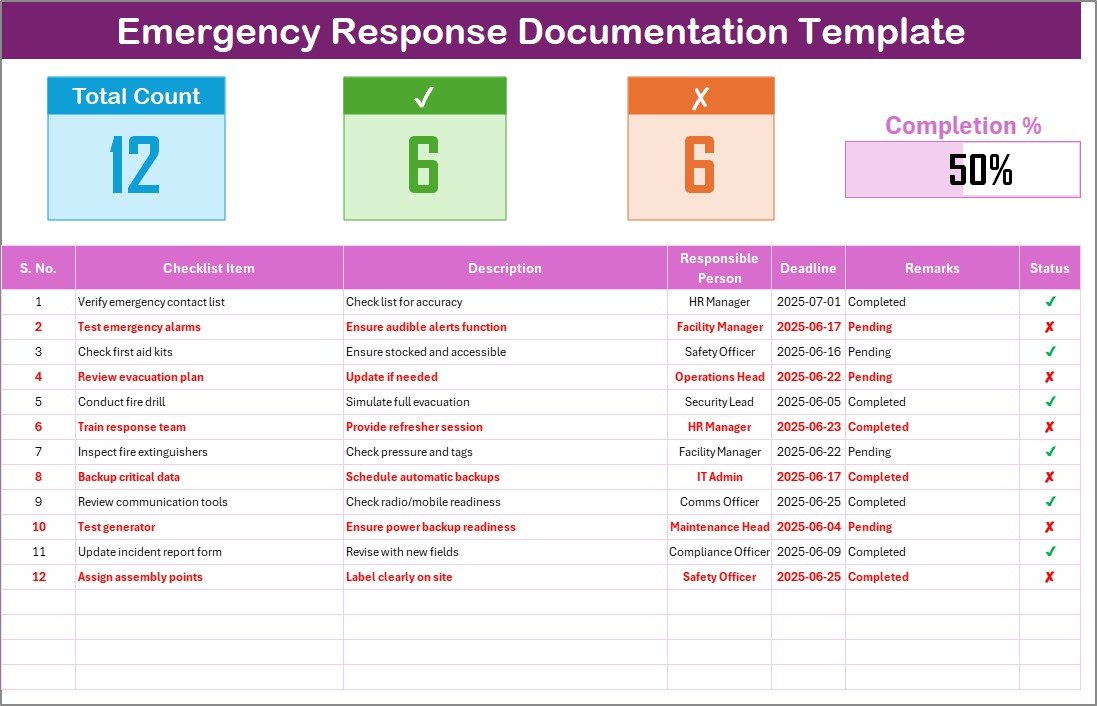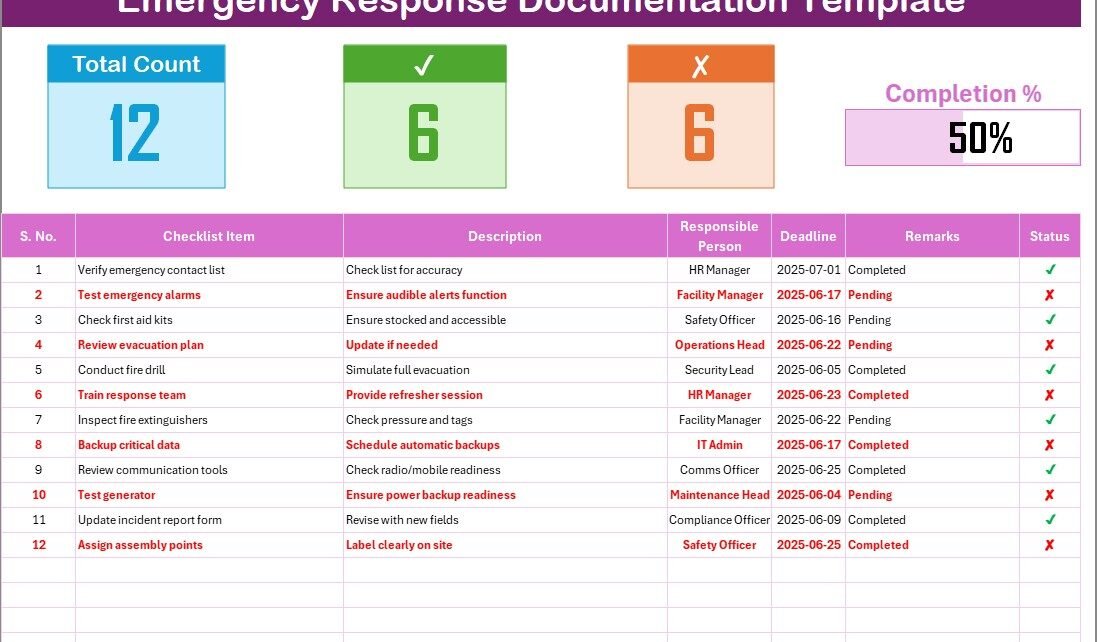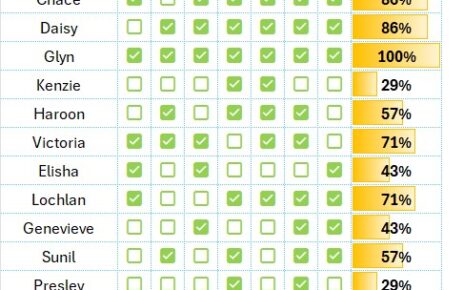In today’s fast-paced and uncertain world, being prepared for emergencies isn’t optional—it’s essential. Whether you’re managing a school, office, hospital, or warehouse, having an Emergency Response Documentation Checklist can make the difference between chaos and calm. Fortunately, using Excel for this purpose provides a smart, accessible, and user-friendly solution.
In this detailed guide, we’ll explore how to create and use an Emergency Response Documentation Checklist in Excel, why it matters, its advantages, best practices, and frequently asked questions—all in one place.
Click to Purchases Emergency Response Documentation Checklist in Excel
What Is an Emergency Response Documentation Checklist in Excel?
An Emergency Response Documentation Checklist in Excel is a structured tool that helps organizations plan, track, and manage their emergency protocols. It outlines critical tasks, assigns responsibilities, sets deadlines, and monitors progress using clear visual cues—all within the familiar and flexible environment of Excel.
It ensures that no step gets missed during an emergency or drill and helps organizations comply with safety regulations and internal policies.
Key Features of the Emergency Response Checklist Template
Our Excel-based Emergency Response Documentation Checklist comes with two functional worksheet tabs designed for simplicity and efficiency:
Emergency Response Review Checklist Sheet

This is the main working sheet where all the checklist information is entered and tracked.
Top Section Highlights:
-
Total Count: Shows the total number of checklist items.
-
Checked Count: Number of tasks marked as complete.
-
Crossed Count: Number of tasks not completed or failed.
-
Progress Bar: A visual indicator of how much of the checklist has been completed.
Click to Purchases Emergency Response Documentation Checklist in Excel
Main Table Columns:
-
Serial No.
-
Checklist Item
-
Description
-
Responsible Person
-
Deadline
-
Remarks
-
Status (✔ for completed, ✘ for not completed)
List Sheet

This is the backend sheet that stores the unique list of Responsible Persons. It supports drop-down selections in the main checklist table to maintain consistency and avoid manual errors.
Why Use Excel for Emergency Response Documentation?
While many tools offer checklist features, Excel remains the go-to choice for several reasons:
✅ Familiar interface—no learning curve.
✅ Easy to customize based on organizational needs.
✅ No need for expensive software.
✅ Compatible across devices.
✅ Visual progress tracking using formulas and conditional formatting.
Advantages of Emergency Response Documentation in Excel
Let’s explore the major benefits of using this Excel-based checklist:
✔️ 1. Centralized Control
All emergency tasks and responsible parties are tracked in one sheet, reducing confusion and duplication.
✔️ 2. Easy to Update and Share
You can easily update statuses, assign new deadlines, or share the file via email or cloud platforms like OneDrive and Google Drive.
✔️ 3. Visual Progress Tracking
With live progress bars and color-coded symbols, your team can immediately see how prepared they are.
✔️ 4. Supports Team Accountability
Clear assignment of tasks ensures each person knows their role, helping avoid missed actions during high-pressure moments.
✔️ 5. Saves Time During Audits
When auditors or compliance officers request your emergency readiness documents, having everything organized in one Excel file saves hours of manual preparation.
How to Use the Emergency Response Documentation Checklist Template
Here’s a step-by-step guide to help you get started:
🔢 Step 1: Open the Template
Download and open the Excel file. You’ll land on the Emergency Response Review Checklist tab.
✍️ Step 2: Fill in the Checklist Table
Enter your emergency response tasks in the Checklist Item column, then complete other columns like Description, Responsible Person, Deadline, and Status.
⬇️ Step 3: Use Drop-down for Responsible Person
Click to Purchases Emergency Response Documentation Checklist in Excel
The drop-down pulls data from the List Sheet, ensuring standardized entry.
✔️ Step 4: Update Status
As tasks get completed or skipped, mark them with ✔ or ✘ in the Status column. The progress bar updates automatically.
📊 Step 5: Monitor the Progress
Check the visual summary at the top to stay informed of completion rates.
Best Practices for the Emergency Response Documentation Checklist
To ensure your checklist is not just a document but a real-time action plan, follow these best practices:
1️⃣ Keep It Dynamic
Review and update the checklist regularly based on new risks, drills, or past incident reports.
2️⃣ Assign Realistic Deadlines
Set achievable deadlines to ensure tasks don’t stay pending when emergencies hit.
3️⃣ Train Your Team
Make sure every person listed under “Responsible Person” knows how to use the checklist and what each task entails.
4️⃣ Back Up Your File
Always keep a copy of your updated checklist on cloud storage to access it from multiple devices in case of emergencies.
5️⃣ Use Conditional Formatting
Apply color codes to quickly differentiate between completed, pending, and failed tasks.
When Should You Use This Checklist?
This tool is especially useful in the following scenarios:
-
Fire drills and evacuation planning
-
Earthquake and natural disaster readiness
-
Pandemic protocols
-
Security threat responses
-
Industrial hazard management
-
School emergency preparedness
-
Hospital and healthcare facility emergency plans
How to Customize the Template for Your Needs
One of the best things about using Excel is its adaptability. Here’s how you can make this checklist your own:
🎨 Change Color Themes: Use your organization’s brand colors.
📅 Add More Columns: Need “Department” or “Priority”? Just insert a column!
📌 Attach Reference Documents: Use hyperlinks in the Description or Remarks column.
📍 Add Filters or Slicers: Quickly sort by Responsible Person, Deadline, or Status.
📷 Insert Icons or Visual Cues: Use emojis or icons to make the sheet more engaging.
Common Mistakes to Avoid
Even the best checklists can fail if not maintained properly. Keep an eye out for these common errors:
❌ Ignoring updates after a drill or incident.
❌ Assigning multiple people without clear task ownership.
❌ Using vague task descriptions.
❌ Missing backup copies.
❌ Setting deadlines without considering availability.
Who Can Use This Template?
The beauty of this checklist is that it’s versatile. Here are just a few types of users who’ll find it invaluable:
🔹 Facility Managers
🔹 School Administrators
🔹 Hospital Safety Officers
🔹 Construction Site Supervisors
🔹 Corporate HR & Admin Teams
🔹 Warehouse Operations Heads
🔹 Event Organizers
Conclusion
Emergencies don’t wait. The key to minimizing damage and maximizing safety lies in preparation. The Emergency Response Documentation Checklist in Excel gives you the power to plan, track, and act quickly—all in a familiar format.
With clear responsibilities, visual progress, and real-time tracking, this template is more than just a list—it’s your blueprint for resilience.
So, don’t wait for a crisis to act. Download the checklist today, customize it for your needs, and lead your team with clarity and confidence.
Frequently Asked Questions (FAQs)
Q1: Can I use this template for fire drills and safety audits?
Absolutely. It’s perfect for fire drills, safety inspections, and emergency readiness documentation.
Q2: Is this template editable?
Yes. You can fully customize it—add rows, change colors, insert new columns, or add filters.
Q3: Can I assign tasks to multiple people?
While you can, it’s best to assign a single responsible person per task to avoid confusion.
Q4: What happens if I forget to update the checklist?
You risk losing visibility over critical tasks. Set calendar reminders or assign someone to manage it weekly.
Q5: How often should I update the emergency checklist?
We recommend reviewing it monthly, or immediately after any drill or incident.
Q6: Can I use this on my phone?
Yes! If you upload the file to Google Sheets or OneDrive, you can access and edit it on mobile.
Q7: Is Excel really enough for emergency planning?
For small to medium organizations—yes! Excel is powerful, flexible, and easy to maintain without extra costs.
Visit our YouTube channel to learn step-by-step video tutorials



